the history of yeovil's pubs
PUBS HOME PAGE |
PUBS INTRODUCTION |
PUBS BY NAME |
BEERHOUSES |
railway inn / tavern
45 Middle Street
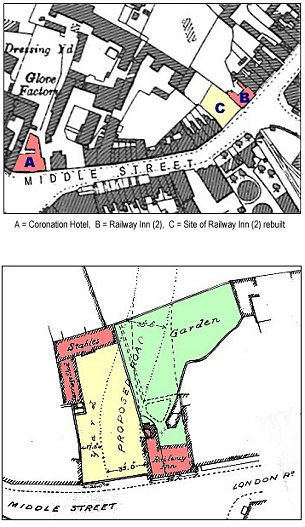 Yeovil
Town Railway
Station opened
in 1861 and the
Railway Inn
(marked 'B' on
the map at left)
probably opened
its doors
sometime during
the years
following -
Yeovil's second
Railway Inn.
While the
station was
located at the
southern end of
Station Road
(now Old Station
Road) the
Railway Inn was
sited in
Middle
Street facing
Station Road
(and the station
itself) as seen
in the first
photograph
below, most
likely in an
existing
building.
Yeovil
Town Railway
Station opened
in 1861 and the
Railway Inn
(marked 'B' on
the map at left)
probably opened
its doors
sometime during
the years
following -
Yeovil's second
Railway Inn.
While the
station was
located at the
southern end of
Station Road
(now Old Station
Road) the
Railway Inn was
sited in
Middle
Street facing
Station Road
(and the station
itself) as seen
in the first
photograph
below, most
likely in an
existing
building.
It appears to have been of two-storeys and double fronted although the photograph below may be misleading. The solid parapet that would mask the roof from ground level clearly has a sign with large lettering saying 'RAILWAY INN' but the first 'N' of the word inn appears to line up with the door below.
Indeed, rather than as seen in the photograph below, the actual width included another couple of windows beyond the edge of the photograph to the left inferring it was significantly larger than the photograph below would at first indicate. The plan at left, based on a plan of circa 1912 that was submitted for the building of the new Central Road, actually indicates that the Railway Inn had a frontage of 43 feet and 2 inches (13m). The dotted line of the proposed new road was not followed and the kink was ironed out such that it entered Middle Street on the site of the Railway Inn.
However, although the first reference I found for the Railway Inn dates to 1870 when Samuel Pretty was licensee, a passing reference in the Western Gazette edition of 27 September 1872 when, in reporting the proceedings of the Borough Petty Sessions, it mentioned ".... Mrs Pretty, of the Rest and Be Thankful Inn (otherwise the Railway Hotel)...." So, it may be that the earlier pub, the Rest and Welcome, was also known as the Rest and Welcome, later becoming the Railway Inn, in which case the latter establishment's origins may stretch back to the 1850s.
To its western side, the site now occupied by Wetherspoons, was a large yard, known as Foot's Yard, (coloured yellow) containing a Carriage Shed (about 40 feet long by 18 feet deep - 12.2m x 5.5m) and a separate Stable Block (about 55 feet long by 18 feet deep - 16.75m x 5.5m). Behind was a large garden (coloured green). The frontage of the yard on Middle Street was 57 feet (17.4m) across and its depth was about 140 feet (42.7m). A large L-shaped garden was to the rear of the pub, some 78 feet (14.6m) deep and about 90 feet (27.5m) at its widest part.
Minutes of the Improvement Committee in April 1876, investigating an "abominable stench which was frequently experienced near Mrs Norman's house, the Railway Inn, Middle Street.... that emanated from the drain underneath the house...". In the minutes it noted that Joseph Brutton was the owner of the inn.
However, the following year, 1877, Elias Whitby Jnr purchased the then Railway Inn from Elizabeth Edwards, with outbuildings, a yard and a garden; also a glove factory and leather-dressing yard in Middle Street near to Townsend, bounded on the north by property belonging to the late William Bide; on the south by Middle Street: on the east partly by premises belonging to Messrs Pittard; and on the west partly be premises belonging to Elias Whitby and partly to George Gracious Style, coach builder.
During late May or early June the Railway Inn caught fire and the Fire Brigade's Minute Book recorded the following - "It was resolved, on a motion of Mr Dimond, seconded by Mr Hull, that the charge for attending the fire at the Railway Hotel, Middle Street, be as follows - 8 men @ 5/- = £2, Engineer = £1.1s., 10 helpers @ 2/- = £1.0.0., Damage to hose 10s., Police 2s.6d., Refreshments 5s.0d. Total = £4.18s.6d."
The Railway Inn (shown in red on the map) was demolished in 1913 when Central Road was constructed and rebuilt almost immediately but in a new position slightly west of the original site (shown in pink on the map). The 'new' Railway Inn was built on the western corner of the newly-built Central Road and Middle Street - the location now occupied by Wetherspoon's William Dampier. The new building (marked 'C' on the top map), brick with a double string course under a tiled roof, was much larger and far grander than its predecessor. It had four large bays, delineated by pilasters, facing Middle Street, each with a large semi-circular window at ground floor level and pairs of sash windows at first floor level, and one large similarly fenestrated bay and three smaller bays, again delineated by pilasters, with single sash windows at high level facing Central Road. Both elevations had entrances but the main double-door entrance was on the angled corner of the building that was surmounted by a grand, coped Swan-necked broken pediment (rounded in the drawing, pointed in the photograph) and a contrasting stone eaves cornice.
From at least 1885 and as late as the time George Hoare was licensee (c1901-c1923) the large yard at the rear of the Railway Tavern was the site used for small circuses and fairs, for travelling performers to put on popular entertainments. or 'Penny Pops' or 'Penny Gaff' as they were commonly called locally. One such was a performance recorded on a travelling theatre notice of the New Star Theatre in 1885.
The new Railway Tavern building only had a lifespan of some fifty years being demolished in the mid-1960's as part of the wholesale redevelopment of this part of Middle Street adjoining the new Glovers Walk / Bus Station complex. The site is now Wetherspoon's William Dampier.
![]()
In 1866 Mr Wills, of the Railway Hotel was 'again refused a spirits license' at the Borough Petty Sessions and the Western Gazette, in its edition of 21 September reported "The Bench, however, held out some hope that it would eventually be granted, if the house was improved, and if it should at any time appear that more accommodation was required at Townsend."
In its edition of 9 September 1870,he Western Gazette, in reporting the proceedings of the Borough Petty Sessions noted "Samuel Pretty, of the Railway Hotel Refreshment-house, having been convicted, his license was renewed with a caution."
Who'd have thought it? - two men called John Norman, both born in Shepton Mallet, both living in Yeovil in 1881 and both publicans; one at the Railway Inn and the other at the Duke of Wellington in Sherborne Road (there was also a third John Norman who wasn't a publican). Little wonder that, without the benefit of easy internet access to the census returns, eminent Yeovil historians Leslie Brooke and Leonard Hayward confused them. The John Norman who ran the Railway was born about 1822 in Shepton Mallet and is found in the 1841 census living in Shepton Mallet with his first wife, Sarah. John's occupation was given as a hatter. In the 1851 census John was licensee of the Royal Oak in Garston Street, Shepton Mallet and was described as a silk turner and beer house keeper. He and Sarah now had a nine-year old daughter, Henrietta, and a baby son, John. By the time of the 1861 census the family had moved to Yeovil and were living in Wellington Street and John's occupation was now a coal merchant. They were living next door to John's older brother, Daniel, and his family. Daniel was also a coal merchant so it is likely that John moved to Yeovil for the job with his brother. In 1866 John Norman was listed in the Post Office Directory as the licensee of the Swan Inn in Park Street and in January 1870 Sarah died, aged 51. John was recorded there in the 1871 census and was still there in 1875. John remarried in July 1875, his new wife, Ellen, was ten years his junior and was born at Long Sutton. In the 1881 census John and Ellen were at the Railway Inn where John's occupation was given as innkeeper. Living with them and working as a barmaid was Ellen's niece, 25-year old Lucy Manning. John died in October 1883. Ellen, or Helen, Pretty, was born around 1834 in Long Sutton, Somerset, the daughter of blacksmith Jephthah Bulgin. She first appears in the 1871 census as licensee of the South Western Arms as a 37-year old widow living with her 16-year old niece Lucy Manning (daughter of Ellen's sister Louisa Manning). Ellen was possibly the wife of Robert Pretty who died in Yeovil a month or two before the 1871 census was taken. Ellen married John Norman in 1875 and was with him in the 1881 census running the Railway Inn just a few yards away from the South Western Arms (many thanks to Leslie Courtis for much of the information concerning Ellen).
In 1891 there were three men called Samuel Foot living in Yeovil but the one who was licensee of the Railway Inn was born about 1840 at Minterne Magna, Dorset, the son of farm labourer Richard Foot and his wife Rosemarie. In 1861 20-year old Samuel, although married, was a boarder at the White Horse Inn in Middlemarsh, Dorset, where his younger brother, John, was an ostler. John and his wife, Sarah, moved around quite a bit; their first child, Emily, was born in Jersey, Channel Islands, in 1872, Ann was born in Dorchester in 1876, Samuel and John in Southampton in 1879 and 1881 respectively and finally Beatrice was born in Yeovil in 1884. Kelly's Directory of 1889 listed Samuel as the licensee of the Railway and the 1891 census saw the family there with Samuel listed as publican and daughters Emily and Ann assisting. I lost track of them after this date.
Of the next licensees I couldn't positively identify either James Forse or John Shiner as licensees, indeed I couldn't find either of them in Yeovil before or after their stints as licensees as listed below.
George Hoare, however, was a different matter - he was born around 1853 in Yeovil, the son of Thomas Hoare a butler (and later a biscuit maker) from Musbury, Devon, and his wife Jane. In the 1861 census Thomas, Jane and their four children were living in Paradise, Huish. This area of Huish near to the town centre, including both sides of the road, was known as Paradise - named after the colloquial name for the burial ground next to Huish School. By 1871 George was listed in the census as a leather parer and all his siblings were employed in the gloving industry. By 1881 George, now aged 28, had married and he and his wife, Susan, were living in Middle Street with three daughters and two sons, all aged seven or less. Both George and Susan were employed as glovers. In 1891George, Susan and nine of their children were living in cramped conditions at Coronation Buildings at the end of Addlewell Lane - one of several small, low-standard, yet cheap accommodation terraces built near gloving factories for the use of the employees. By 1899 George had moved his family out of the squalid Coronation Buildings and into the Railway Inn where Whitby's Yeovil Almanack Advertiser first lists him as its licensee. In the 1911 census George was listed as publican (innkeeper) and it was noted that he and Sarah had been married for forty years and had thirteen children, eleven of whom survived. It was just two years later that the old Railway Inn was demolished for the building of Central Road and the new Railway Inn erected on the corner site as seen in the photographs above. George remained licensee until his death in December 1929 at the age of 76 - a total of thirty years as licensee.
I'm not sure when Harold Dennett took over the Railway, it may have been straight after George's death but was certainly by 1936 when he was listed in the Yeovil Directory. Harold was to serve as licensee at least until 1960.
gallery
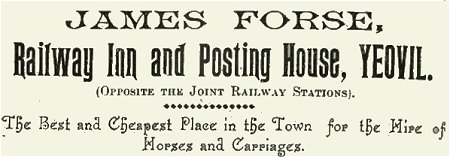
An advertisement for James Forse's Railway Inn from the 1894 edition of the Western Gazette Almanac.
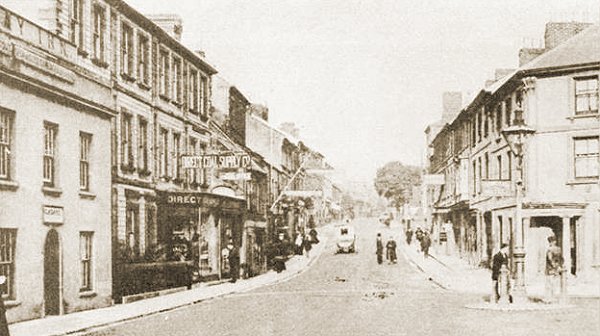
A photograph of Lower Middle Street, dating to about 1900, shows the Railway Inn at extreme left projecting slightly beyond the terraced building next to it. Note the truncated 'Railway Inn' signage fascia at roof level indicating that only about half the Railway Inn appears in the postcard. The photographer is standing roughly outside where the William Dampier is today and looking along the eastern end of Middle Street with Station Road (now Old Station Road) at right. The large building on the junction at right was the Fernleigh Temperance Hotel and is currently an Indian restaurant. This incarnation of the Railway Inn was demolished in 1913 to allow for the construction of Central Road and the new Railway Tavern was built to one side - on the corner now occupied by the William Dampier. The site of this first Railway Tavern is now the end of Central Road (at the traffic lights outside the William Dampier) - see photo below.
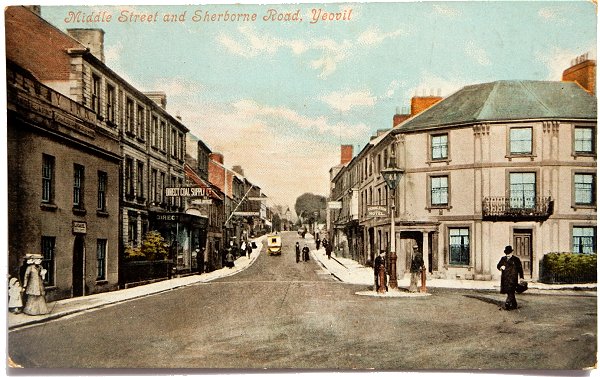
From my
collection
An all but identical view to the previous photograph, this postcard appeared in several forms - monochrome and at least three different hand-coloured versions. This one was used in 1907.
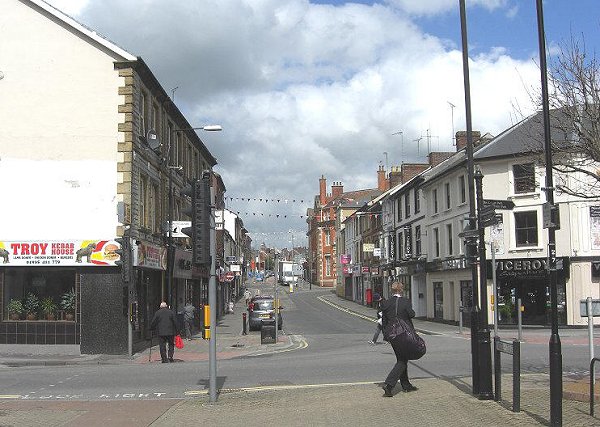
The same view as above but taking in 2012. The original Railway Inn has gone, replaced with Central Road, but the building next to it housing the kebab shop remains, as does the old Fernleigh Temperance Hotel building at right. The frontage of the original Railway Inn, bearing in mind that it projected further towards the road than its neighbours, would have been roughly where the red bag is belonging to the man crossing the road. This particular junction is today ruined by a plethora of street furniture - lights, cameras, traffic lights, signs, etc.
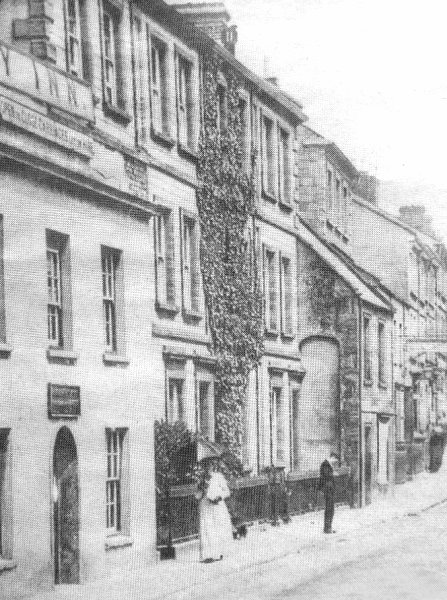
Courtesy of the
Western Gazette
Part of the Railway Inn (at left), photographed around 1895.

A colourised photograph of the men of the Yeovil Cadet Corps and Boys' Brigade marching along Middle Street past the Railway Inn (at top left) around 1914.
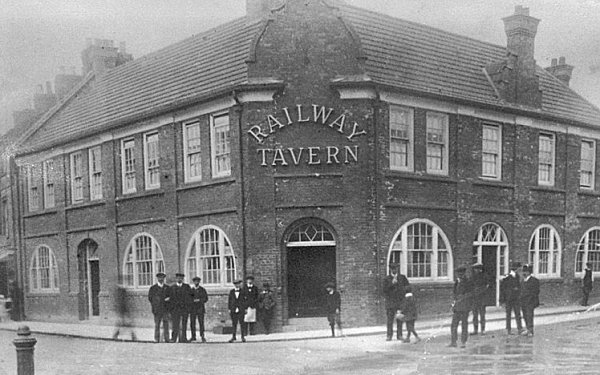
This
photograph
features in my
book "Lost Yeovil"
This photograph dates to about 1915 and shows the second version of the Railway Tavern in Middle Street. At right is the entrance to Central Road, constructed in 1913, with the Railway Tavern constructed shortly thereafter. The site is now Wetherspoon's William Dampier.
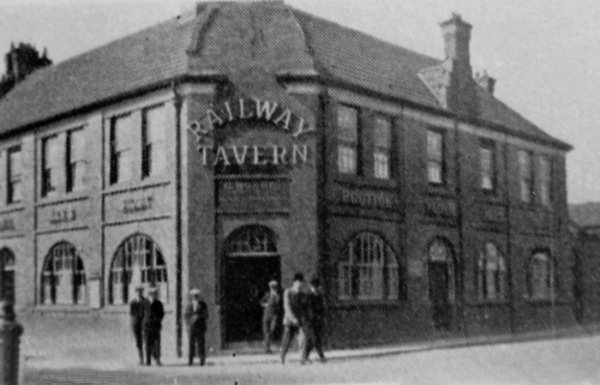
From my
collection
The Railway Tavern, photographed in the early 1930s.
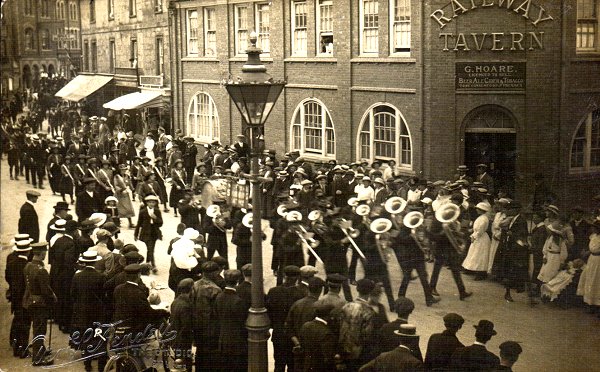
A parade passing the Railway Inn when George Hoare was landlord, dating the photo to between 1913 and 1923.
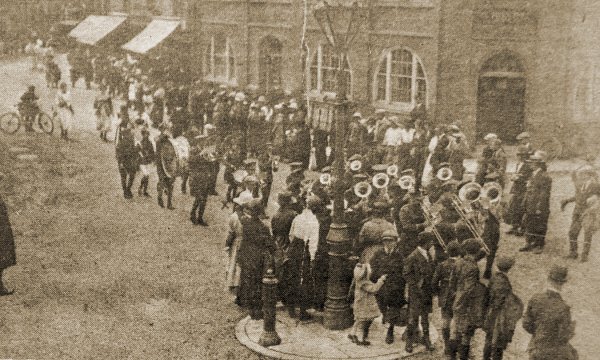
Courtesy of
Colin Haine
Possibly the same parade? This photograph, published in a local newspaper, is known to be the band of the Somerset Battalion of the Boy's Brigade from a time when the Boy's Brigade wore khaki uniforms.
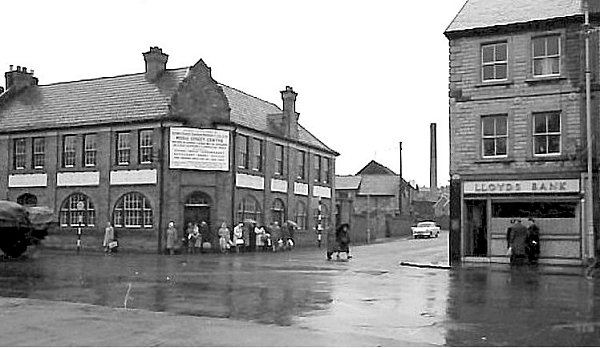
The Lloyd's Bank building (now a Kebab shop) at right is clearly part of the terrace seen in the first photograph. This view of Central Road shows the second version of the Railway Tavern, by this time in the early 1960's closed and boarded up. To the rear of the Railway Tavern was Whitby’s Glove factory and Shillabeer's builders yard and offices.
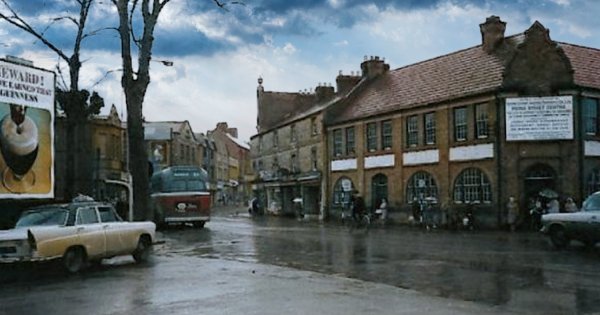
This colourised photograph, again taken in the early 1960's just before the Railway Tavern was demolished, looks along Middle Street from the corner of Station Road (now South Western Terrace). One of the few buildings remaining today, the Liberal Club, is just visible between the trees at left.
owners / lessees / licensees
1866 – Mr Wills -
Spirit license
refused
(Borough Petty
Sessions,
September)
1870 – Samuel
Pretty - license
renewed with
caution
(Borough Petty
Sessions)
1872 – Mrs
Pretty - "of the
Rest and Be
Thankful Inn
(otherwise the
Railway Hotel)"
License
renewed
(Borough Petty
Sessions)
1877 – Elizabeth
Edwards, owner
(see note re
transaction
above)
1877 – Elias
Lyndall Whitby,
owner (see note
re transaction
above)
1881 – John
Norman – Inn
Keeper (1881
census) listed
as Railway Inn
1882 – John
Norman (Whitby's
1882 Yeovil
Almanack
Advertiser)
listed as
Railway Inn
1889 – Samuel
Foot – Beer
Retailer
(Kelly’s 1889
Directory)
listed as
Railway Inn
1891 – Samuel
Foot – Publican
(1891 census)
listed as
Railway Inn
1892 – Benjamin
Gay – license
transfer
(Borough Petty
Sessions)
1894 – James
Forse (1894
Western Gazette
Almanac)
1895 – James
Forse – Beer
Retailer
(Kelly’s 1895
Directory) pub
not named
1897 – Mrs
Zillah Forse –
Beer Retailer
(Kelly’s 1897
Directory)
listed as
Railway Inn
1898 – John
Shiner (Whitby's
1898 Yeovil
Almanack
Advertiser)
1899 – George
Hoare (Whitby's
1899 Yeovil
Almanack
Advertiser)
1901 – George
Hoare – Leather
Parer &
Innkeeper (1901
census) pub not
named
1911 – George
Hoare –
Innkeeper (1911
census)
1913 - The pub
was demolished
and rebuilt
1914 – George
Hoare – Beer
Retailer
(Kelly’s 1914
Directory) pub
not named, but
the 'new'
Railway
Tavern building
1916 – George
Hoare (Whitby's
1916 Yeovil
Almanack
Advertiser)
1923 – George
Hoare – Beer
Retailer
(Kelly’s 1923
Directory) pub
not named
1936 – HB
Dennett (1936
Yeovil
Directory)
listed as
Railway Tavern
1938 – HB
Dennett (1938
Yeovil
Directory)
listed as
Railway Tavern
1939 – Harold
Dennett (Kelly’s
1939 Directory)
listed as
Railway Tavern
1947 – HB
Dennett (1947
Yeovil
Directory)
listed as
Railway Tavern
1949 – HB
Dennett (Kelly’s
1949 Directory)
listed as
Railway Tavern
1951 – HB
Dennett (1951
Yeovil
Directory)
listed as
Railway Tavern
1954 – HB
Dennett (1954
Yeovil
Directory)
listed as
Railway Tavern
1957 – HB
Dennett (1957
Yeovil
Directory)
listed as
Railway Tavern
1960 – HB
Dennett (1960
Yeovil
Directory)
listed as
Railway Tavern
1965 – Licensee
not named (1965
Yeovil
Directory)
listed as
Railway Tavern